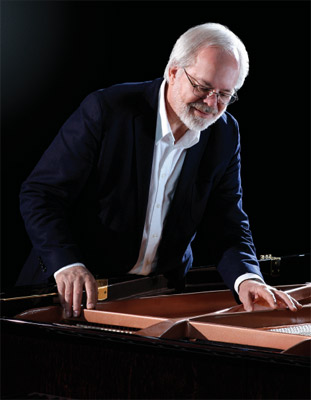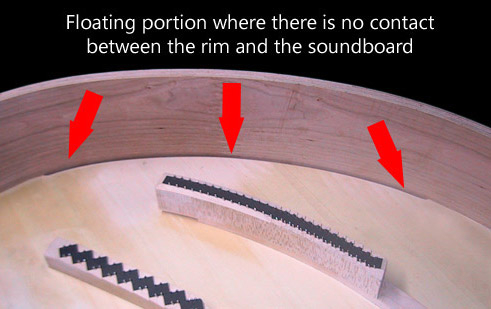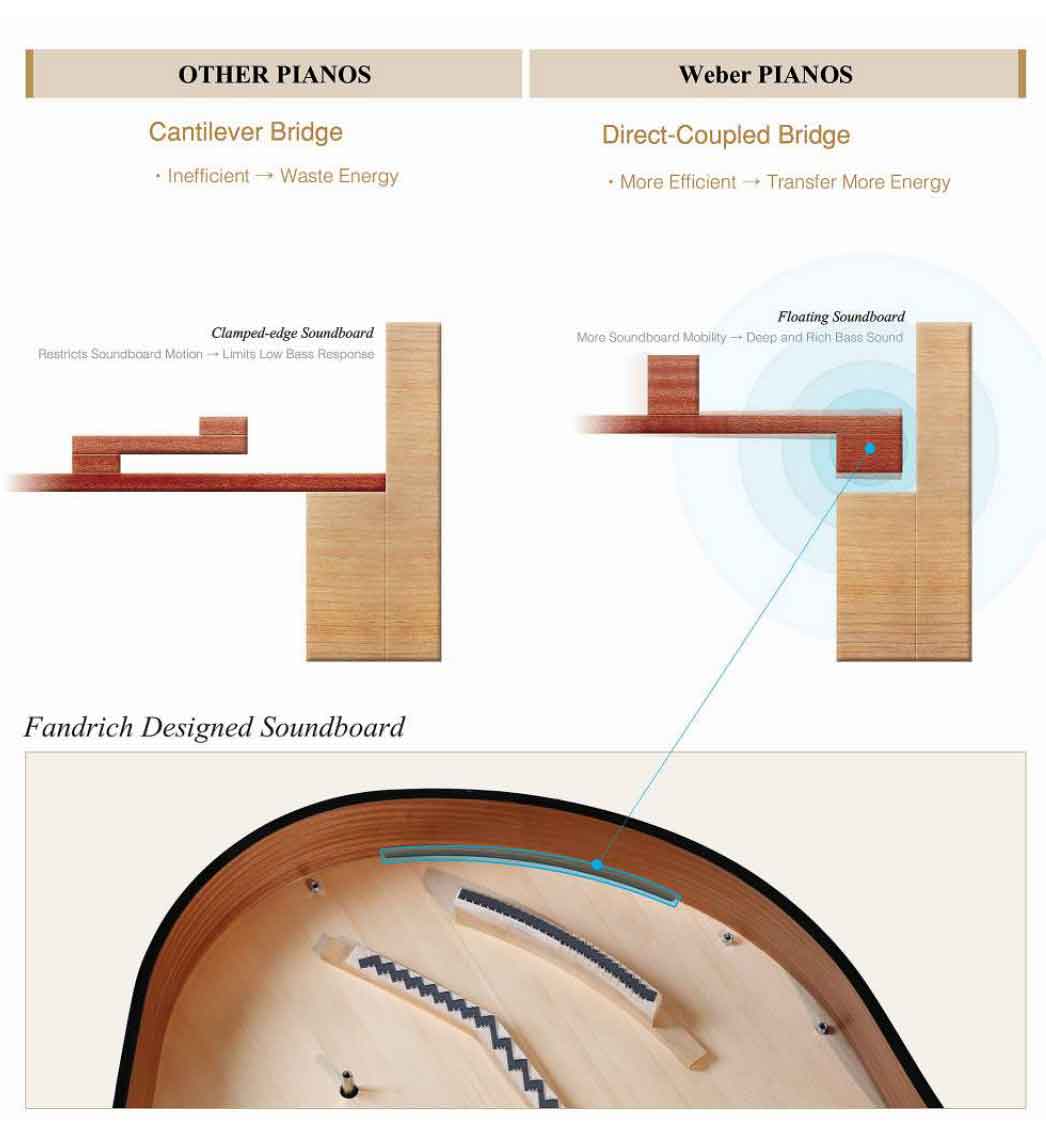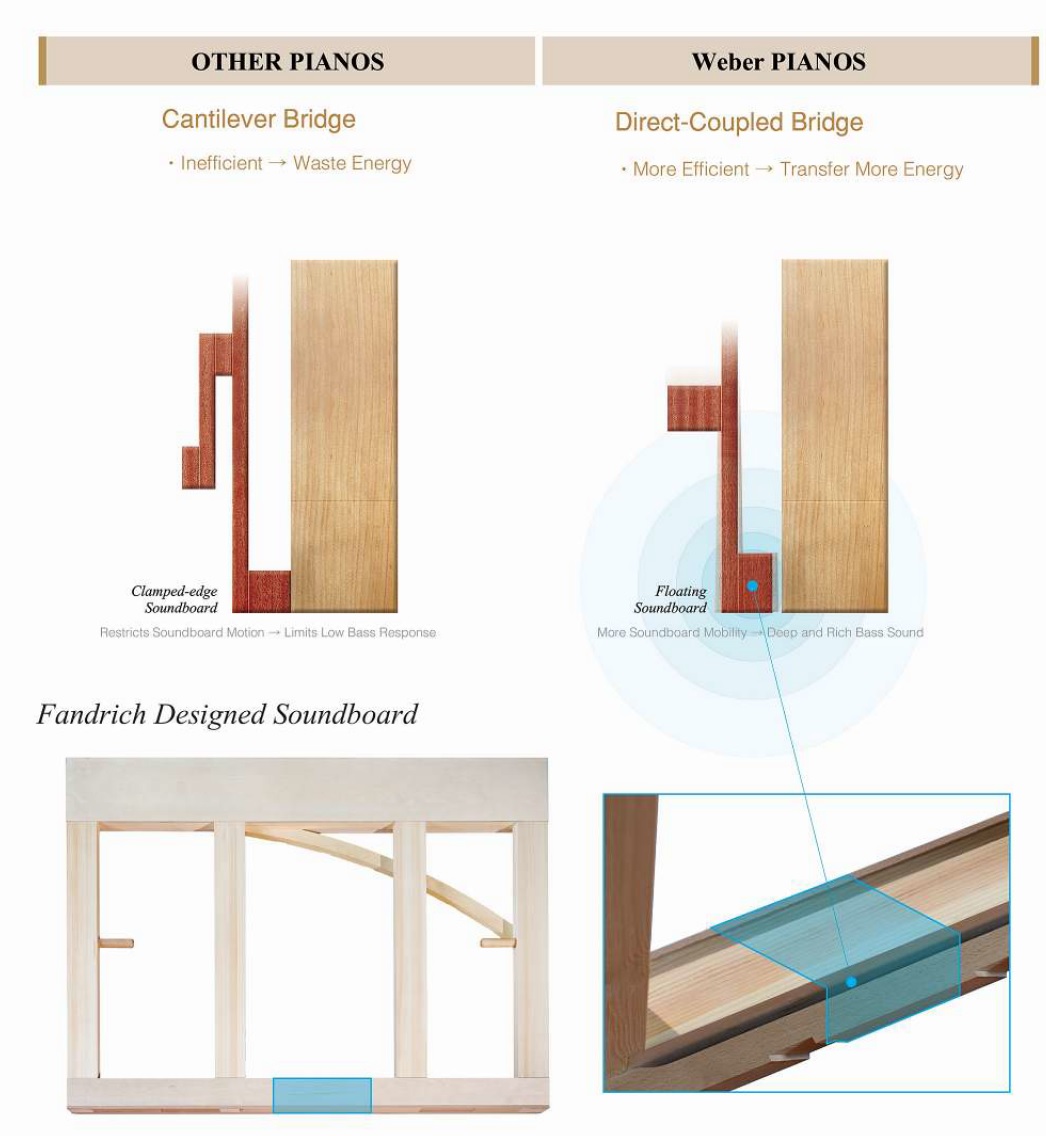Floating Sound Board
In 2008 Young Chang hired noted American piano designer Delwin D. Fandrich to undertake a redesign of the entire Young Chang and Weber piano line. Highlights include extensively redesigned cast-iron plates, new string scales, and new rib designs. New directly-coupled bass bridges, along with unique “floating soundboard” configurations, improve soundboard mobility around the bass bridge for better bass tonal response. At the same time, a revised hammer-making process, in which the hammers are cold-pressed with less felt compression, provides for greater hammer resilience and improved tone, with less voicing required. Fandrich says that all of these features and processes contribute to his goal of building instruments with improved tonal balance and musicality, and provide opportunities to standardize manufacturing processes for better quality control. The new designs were phased in gradually from 2011 to 2013.

Interview with Fandrich
How long have you been consulting for Young Chang pianos? Young Chang, for readers who aren’t aware is considered one of the “big 5” Asian pianos ~ being Yamaha and Kawai (from Japan), Samick and Young Chang (from Korea) and now Pearl River (China) who collectively manufacture hundreds of thousands of pianos annually.
In late 2007 I was asked by Phil Glen—then Technical Services Manager for Young Chang—to prep one of their concert grands for the National Association of Music Merchants (NAMM) show and, when finished, write a report on both the condition of the piano and its design, which I did. This led to my being asked to meet with the company’s new Chairman, Mr Park, following which I was asked to visit their factories in Incheon, Korea, and Tianjin, China. That led to the request to redesign the entire product line. The company had just been purchased by Hyundai and its new management wanted to divest itself of the past and develop a product line that was uniquely Young Chang. I’ve been making roughly six trips a year to Korea and China ever since. The design work was completed by late 2009, and since then my work involves helping the company to implement them and generally improve their production processes and quality control.

When I spoke with you at NAMM convention a few years back you had introduced me to the concept of “floating” soundboards. Sandwiched between the rim and the cast iron frame weighing upwards of 500 pounds or more, and having roughly 225 wires holding nearly 18 tons of string tension, having a soundboard that “floats” seems paradoxical. How exactly does that happen?
Broadly speaking, the concept of “floating” the soundboard simply means that some part of the soundboard system is not solidly attached to the inner rim (grands) or the liners (uprights) through some part of its perimeter. The idea did not originate with me. I first saw this idea implemented in early 20th Century American-made pianos such as the Mehlin grand. (There were others but this is the one that comes to mind.) I later encountered the feature in the Holland-built Rippen vertical pianos. There are also a few U.S. patents on the concept by inventors such as Howard Graves (all of whose patents make worthwhile reading). I was intrigued with the design feature and spent some time experimenting with various applications, which led to the implementation I used in my 122 Fandrich upright and the Walter 175 grand. In the upright I attached the soundboard panel to a hard maple liner and left a gap between the liner and the back panel. This was similar to the configuration found in the Rippen though I did not make the float quite as long.
In the grands, a slot is cut in the inner rim (before the outer rim is attached) about 25 mm down from the top surface and a relief cut is made in the inner rim along this length to provide a space of about 5 mm between the soundboard panel and inner rim section and the outer rim. It has been my experience so far that some float is good, too much introduces tuning problems. I’ve designed some float in all of the smaller (185 cm and shorter) Young Chang/Weber grands and all of the vertical pianos.
And so what are the advantages then of having a floating soundboard?
The benefit is improved freedom of movement around the lower end of the bass bridge. It also makes it practical to remove the bass bridge cantilever but that is another story (see below). This increased freedom of motion enables the soundboard to respond to the coupled energy from the strings at lower frequencies. A fundamental rule of sound production is that if you want to create sound energy at low frequencies you have to be able to move a lot of air. In very large pianos this is less of a problem; the bass bridge is relatively far out toward a somewhat flexible portion of the board. In short pianos, however, placing the bridge close to the inner rim makes it impossible for the board to respond to lower frequencies. Hence the muddy, indistinct tone quality of most pianos shorter than roughly 180 to 190 cm. In the redesigned pianos in which I’ve done this the clarity of the low bass has been significantly improved over the more traditional design. And it’s not just a perceived improvement. Extensive signal analysis has shown that there actually is more sound energy in the lower partials of the sound envelope and this adds clarity to the sound and improves pitch identification.
Would that floating soundboard ever have any structural repercussions long-term?
These systems have been used long enough now that if there were any associated problems with the design they would have shown up by now. The only problem I’ve seen so far is that if it is overdone—i.e., made too long—there can be some tuning instability in the low end of the scale. As with everything else in the piano it’s a compromise. The float, incidentally, is only done through the bass section around the lower end of the bass bridge.
In past, correct me if I’m wrong but the way that manufacturers accomplished longer speaking length was to have a cantilevered bass bridge. How does the floating concept compare to cantilevered system?
The two are not mutually exclusive. In other words, you could use a bass bridge cantilever along with a floating section. But one of the advantages of the floating soundboard system is that it becomes practical to completely remove the bass bridge cantilever. I cannot think of any logical reason to use a bass bridge cantilever in any piano of any size.


It has long been taught that one of the most important design features of a short piano is to somehow fit the longest possible speaking length in there. Unfortunately this means placing the bridge very close to the inner rim. Also unfortunately there is very little flexibility in the soundboard system back there so the “solution” has been to place the bridge body on a cantilever and make the physical attachment to the soundboard panel some further out into the body of the soundboard system. In theory this is supposed to transfer energy from the vibrating string(s) to the soundboard system. In the case of the low bass section of the piano this includes energy at very low frequencies. The biggest problem with the bass bridge cantilever is that it very effectively filters out all of the low-frequency energy that it is supposed to be transmitting to the soundboard system. This energy is absorbed into the cantilever system (i.e., converted into heat) and is no longer available to move the soundboard. The second problem is that it demands a very short backscale. This short backscale acts as a clamping mechanism, restricting the motion of the soundboard system. This is a concept that should be understood intuitively but we’re so used to the old bass bridge cantilever system that sometimes it takes hands-on (ears-on?) proof to convince people that this really works. Being able to conduct and demonstrate this experiment is one reason why I built my string-testing frame; I can compare the two designs side-by-side. In every case where I have demonstrated this comparison to technicians they have—sometimes to their great surprise—agreed that the combination of a shorter speaking length, longer backscale and directly coupled bridge (no cantilever) gives a substantially improved bass tone.